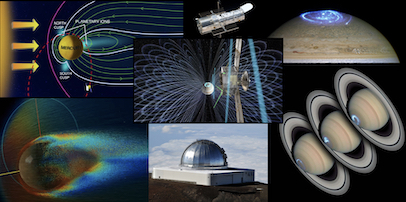Planetary Science
Planetary Magnetospheres and Ionospheres
 Planetary magnetospheres and ionospheres are the solar system's natural laboratories for studying space plasma physics. Though governed by the same fundamental forces of nature, each planet presents a strikingly different space environment. Planetary magnetospheres thus allow us to study how space plasmas behave in very different conditions, and offer a glimpse into the behaviour of more distant astrophysical objects such as exoplanets and pulsars, that we cannot study up close with spacecraft. We at Leicester have played a prominent role in shaping our understanding of the magnetospheres and ionospheres of the other planets, through involvement in a flotilla of interplanetary missions, Earth-based observations of planetary auroras using some of the world's largest telescopes, and via theoretical and computational modelling.
Planetary magnetospheres and ionospheres are the solar system's natural laboratories for studying space plasma physics. Though governed by the same fundamental forces of nature, each planet presents a strikingly different space environment. Planetary magnetospheres thus allow us to study how space plasmas behave in very different conditions, and offer a glimpse into the behaviour of more distant astrophysical objects such as exoplanets and pulsars, that we cannot study up close with spacecraft. We at Leicester have played a prominent role in shaping our understanding of the magnetospheres and ionospheres of the other planets, through involvement in a flotilla of interplanetary missions, Earth-based observations of planetary auroras using some of the world's largest telescopes, and via theoretical and computational modelling.
In the outer solar system, the most-studied planets are Jupiter and Saturn. Jupiter's magnetosphere is the largest and most powerful in the solar system, and, unlike the Earth's magnetosphere which is controlled largely by the solar wind, Jupiter's magnetosphere is driven largely by the planet's swift sub-10 h rotation and interaction with its moons. Saturn's magnetosphere is also rotationally dominated but with unique characteristics such as its enigmatic oscillations close to the planetary rotation period and `ring rain`. The Ice Giants Uranus and Neptune present fascinating and highly unusual magnetospheres that as yet are largely unexplored. In the inner solar system, Mercury has a unique magnetosphere that is comparable to the planet in size, and is strongly driven by the solar wind. Venus and Mars have no global magnetic field, allowing the solar wind to impinge directly on the planets' upper atmospheres, but in the latter case, small-scale 'crustal' fields modify the interaction, which has significant implications for the evolution of the Martian atmosphere and its potential for past or present life.
Central to our studies have been involvement in international space missions. We are the Principal Investigator institution for the MIXS instrument on the ESA Bepi-Colombo mission to Mercury, and have/had Co-Investigator roles on the NASA/ESA Cassini mission to Saturn, the NASA Juno mission to Jupiter and the ESA JUICE mission to Ganymede. We have used data from many other NASA and ESA missions including Galileo, Messenger, Voyager, Mars Express, MAVEN, Ulysses, and New Horizons. We also regularly lead telescope observations of the auroras of the other planets, notably using the Hubble Space Telescope, the Very Large Telescope, and the NASA Infrared Telescope Facility. Theoretical modelling has concentrated on large-scale current systems which transfer angular momentum between the planet and its external environment.
Areas of interest
- The surface-magnetosphere-solar wind interaction at Mercury.
- The interaction of Mars with the solar wind and the effect on the evolution of its atmosphere.
- Large-scale current systems driving dynamics and auroral emissions at Jupiter and Saturn.
- The interaction of rapidly rotating planets with satellites such as Enceladus, Io and Ganymede.
- The behaviour of the outer planets' far ultraviolet and infrared auroras and relation to magnetospheric processes.
- The extension of our understanding of planetary systems to astrophysical bodies such as exoplanets and cool stars.